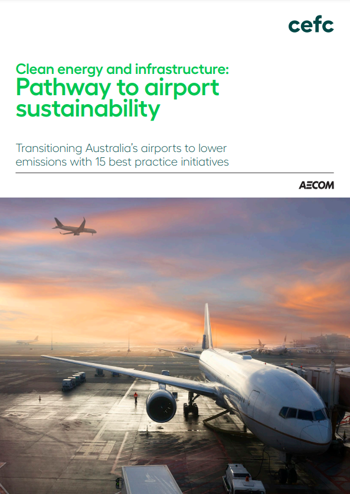
Insights
Clean energy and infrastructure: Pathway to airport sustainability
Fifteen initiatives that airports can adopt to reduce their carbon footprint
This report sets out 15 best practice initiatives to help Australian airports accelerate their transition to lower emissions. It brings together technical and financial insights, and covers both landside and airside opportunities.
About this report
Clean energy and infrastructure: Pathway to airport sustainability
February 2020
Clean energy and infrastructure: Pathway to airport sustainability was developed by the CEFC, with analysis from leading global infrastructure analyst AECOM.
Read moreAs a specialist investor in clean energy opportunities, the CEFC has a particular focus on working with infrastructure asset investors, owners and operators to help them deliver a more sustainable low emissions operating profile. Airports are complex infrastructure assets – and a lack of awareness of clean energy opportunities can be a major barrier to the required investment. This report helps bridge that information gap.
about the industry
Aviation market drivers
- Airports face considerable climate-related risks, from sea level rises to extreme weather events and changing investor and passenger preferences.
- Airport-controlled activities produce some 15 to 20 million tonnes of carbon emissions annually. While many airports are showing a reduction in CO2-e emissions per passenger, the task will become more challenging with global air travel activity predicted to double to 8.2 billion passengers by 2037.
- There is a global movement toward climate neutrality within the aviation industry, including a commitment from the Airport Council International – Europe to achieve net zero carbon emissions by 2050.
report findings
Market potential
- Initiatives such as energy efficient baggage handling systems could reduce carbon emissions by up to 75 per cent compared with business as usual (BAU). Energy efficient airport lighting upgrades and the use of ground source heat pumps could cut emissions by as much as 50 per cent compared with BAU.
- The electrification of ground support equipment and the introduction of onsite solar and battery storage could each deliver as much as a 100 per cent reduction in emissions compared with BAU, through fuel switching and the use of renewable energy. These initiatives typically have a payback period of less than 10 years.
- Innovative energy-from-waste technologies could enable airports to mitigate biosecurity waste handling and disposal by generating renewable, baseload gas, heat or electricity, for use onsite or export to the grid.
- The total capital expenditure for the majority of the initiatives is less than 0.5 per cent of the total airport asset value.





